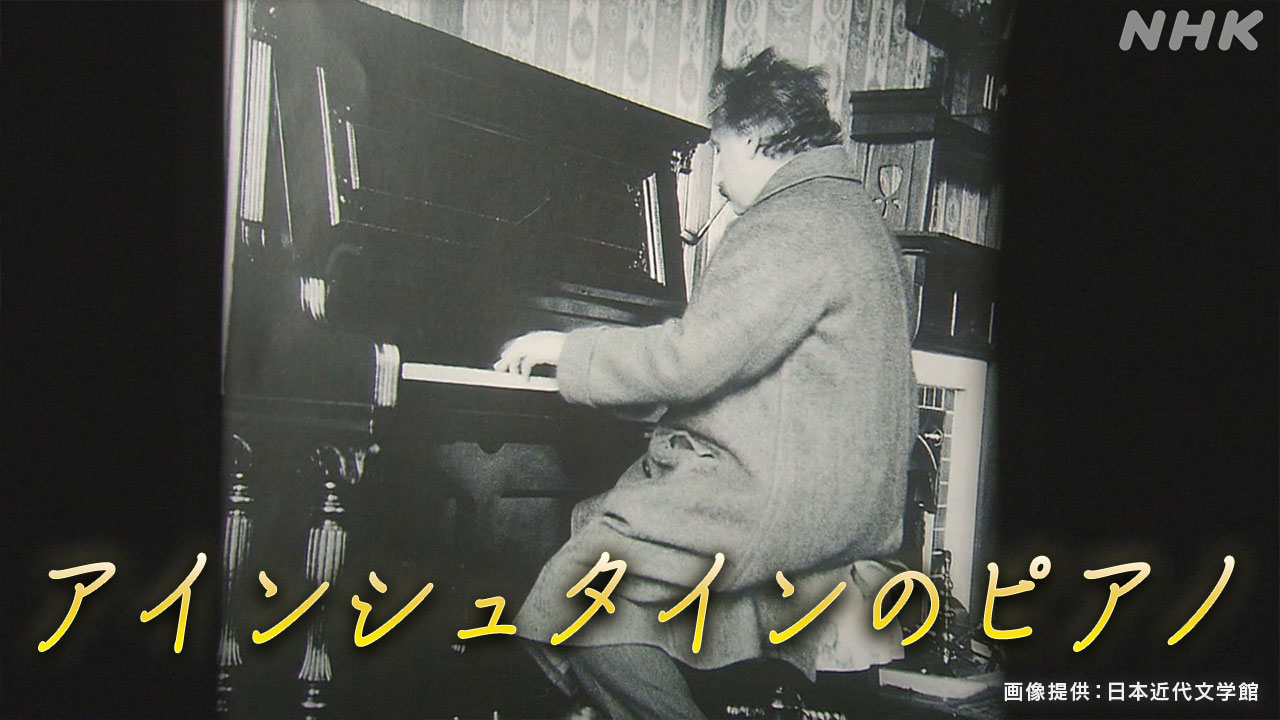A piano nicknamed "Einstein's piano"
is carefully displayed at a long-established hotel in Nara City.
Manufactured in the United States around 1900, the keyboard uses ivory, which is rare today.
However, over time, the parts began to deteriorate.
In order to preserve the piano's tone for future generations, extensive repairs were carried out this year.
(Nara Broadcasting Station reporter Ayae Yoshii)
*At the end of the article, you can listen to and compare the piano tones before and after repair.
Einstein, the world-famous physicist.
About 100 years ago from November 17th to December 29th, 1922.
At the invitation of a Japanese publisher, he and his wife Elsa visited Japan for the first time.
He has long had a strong interest in Japan, and during his stay there he gave lectures and enjoyed sightseeing in various locations from Kyushu to Tohoku.
Einstein feeding the deer
December 17th, one month after coming to Japan.
I visited Nara and stayed for 2 nights and 3 days.
This is what he writes about Nara in his own notes:
"Deer that are used to people come in herds."
"They come up to people and sniff around."
His whereabouts are unknown for a time
Einstein playing the piano
The night of December 18th.
When Einstein returned to his hotel from a trip, he played the piano that was in the lobby of the hotel where he was staying.
He is photographed wearing a coat, smoking a pipe, and playing relaxed.
However, after the Pacific War, the piano was removed from the hotel by the then-Osaka Railway Administration Bureau in order to escape its requisition by GHQ, and its whereabouts were never known.
It was not until 1992, nearly 50 years later, that its whereabouts were discovered.
An employee who was sorting out supplies and other items due to the relocation of JR West's head office discovered it in an underground warehouse.
This photo served as a clue and it was determined that this was the piano that Einstein played.
Approximately 120 years after production, it has already reached its limit
“Einstein’s piano” returned to the hotel.
Tuning and repairs were carried out at this time, but we tried to preserve the original sound by using as much of the original material as possible.
After that, the piano was displayed in the hotel lobby for 12 years and concerts were held there.
However, more than 120 years after its manufacture, it had already reached its limits.
When I played the keyboard, a part of it would not return.
The most serious problem was the part called the hammer, which struck the strings directly and produced a sound.
The felt around the tree had worn away and was almost gone.
If you continue to play the piano in this state, it will break.
The hammer needs to be replaced, but the material is no longer the same as it was 120 years ago, so replacing the parts will change the tone.
Same as the “original sound” as much as possible
``Even if the tone changes, we want many people to continue listening to it'', so
the hotel decided to repair it.
Tuner Yasuyuki Kita was entrusted with the repairs.
For over 10 years, he has been in charge of tuning and repairing this piano.
The hotel's request was to retain as many parts as possible from 120 years ago.
Tuner Yasuyuki Kita
: ``The hotel wanted the tone to be as close to the original as possible.The original had a pretty hard sound.''
Repairs were carried out in a dedicated workshop.
Mr. Kita repaired the hammer to get it as close to the "original sound" as possible, even replacing parts of the hammer.
So I chose a hammer with the hardest felt.
However, that alone cannot bring the sound closer to the "original tone."
Use a needle-like tool to soften the felt part little by little.
Then I sanded down the surface.
Repeating this process, each of the 88 hammers was carefully finished.
Then, while checking the tone many times, I got it closer to the "original tone."
The sound of "Einstein's piano" echoed through the workshop.
Tuner Yasuyuki Kita
: ``It's a piano after all, so I want to get a good sound.''
The piano returned to the hotel again.
February 7th.
The repaired piano returned to the hotel for the first time in three weeks.
Employees who were looking forward to it gathered in the lobby.
One of the employees immediately hit the keyboard to check the tone.
Employee
: “I think the sound is clear.”
The broken keyboard was also repaired.
Employee
: ``There were some keys that wouldn't return after being pressed once, but they've been fixed.''
What is the tone like after restoration?
February 23rd.
A concert was held at the hotel to unveil the newly restored "Einstein Piano."
A jazz pianist from Nara Prefecture performed six songs, including ``When You Wish Upon a Star'' and ``Come Spring.''
Visitors closed their eyes and listened intently to the echoing tones.
A woman from Osaka said
, ``The sound is softer than before the repair, and I loved listening to it.I want it to be preserved for future generations.''
Akane Tsugawa, Nara Hotel
: ``Watching the concert, I thought that even though the sound may have changed since then, the piano that Einstein played will continue to be loved.It will continue to be loved even 100 or 200 years from now. I'm glad I made the decision to have fun with it. The piano seems to be enjoying it too. I feel like I've been reborn."
“Einstein's piano” will continue to deliver its sounds to many people.
Click here to see the difference in tone before and after restoration!
Performance before restoration “Ue o Muite Arukou”
Performance after restoration “Spring is coming”
(Broadcast on “Nara Navi” on February 14th and “Hotto Kansai” on February 15th)

